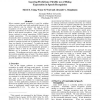26 search results - page 2 / 6 » Automatic speech recognition for assistive writing in speech... |
ICASSP
2011
IEEE
12 years 9 months ago
2011
IEEE
In this work we concentrate on generating compound words with high order n-gram information for speech recognition. In most existing compound words generation methods, only bi-gra...
IJCAI
1989
13 years 6 months ago
1989
entional user behavior, we need a principled mannerAbstract for relaxing contextual constraints when they are violated.When computer speech recognition is used for problem In order...
CHI
2004
ACM
14 years 5 months ago
2004
ACM
Editing speech data is currently time-consuming and errorprone. Speech editors rely on acoustic waveform representations, which force users to repeatedly sample the underlying spe...
LREC
2008
13 years 6 months ago
2008
ProPOSEL is a prototype prosody and PoS (part-of-speech) English lexicon for Language Engineering, derived from the following language resources: the computer-usable dictionary CU...
ICASSP
2009
IEEE
14 years 3 days ago
2009
IEEE
When exposed to environmental noise, speakers adjust their speech production to maintain intelligible communication. This phenomenon, called Lombard effect (LE), is known to consi...

